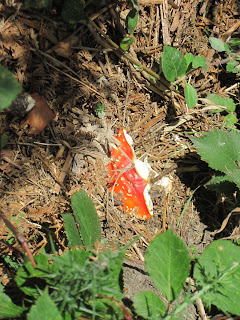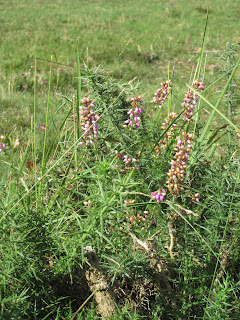
This is a flashback to our recent holiday in the West Country. One of my reasons for starting a blog, almost a year ago, was to collect photographs from holidays or outings into some sort of order. Digital cameras are easy and useful, but in the backlog of images from a holiday, it is too easy to feel overwhelmed and leave them languishing on a memory card, never to be seen again. So, my project for "Rainy Days" is to get some of these sequences of photos sorted out.
A Dartmoor Afternoon
Mid afternoon, after a showery, late August morning. We drove northwards from Tavistock and the valley of the River Tavy, up onto the long climbing road to the edge of Dartmoor. Over a rumbling cattle grid and onto the moor, the first outcrops of grey granite appeared out of sheep-nibbled , grassy heathland.

Dry stone walls edged farm fields that bordered the moor.

We drove on for several miles, to a place on the map where two roads meet. Two Bridges is now just a country junction, with an old coaching inn beside the West Dart River in a sheltered , green valley. Once a meeting place for people who lived at each side of Dartmoor, Two Bridges held a Potato Market in earlier times.
Finding a footpath along an old farm track, we walked along a ridge, beside rough pasture that bordered the river as it ran its course from high moorland and down towards the valley.
Getting up from an afternoon sleep.....

...to graze rough pasture among sedges and thistle stalks beside the river.

Rough hewn dry stone walls fenced in the sheep. Here, a stone had tumbled out of the jigsaw of the wall to leave a picture frame window into fields beyond.

Looking up the valley, onto moorland and a forestry plantation.

Beside the track, old walls stretched up the hillside. A Rowan tree was heavy with ripening berries.Heather and dwarf gorse buzzed with the hum of visiting bees.

The lane led us to a small Dartmoor farmhouse, and then the way went upwards across fields, towards the higher moor.

Looking backwards along the river valley, where glinting water rushed and tumbled over rocks.

Gateposts of granite monoliths between the dry stone walls. Most dry stone walls in the highlands of Britain have their origins in field boundaries many hundreds of years old. In farms that have belonged to generations of the same family, the walls are maintained by descendents of the men who built them first.

The farmhouse, where a small generator whirred electricity from an outhouse.

This would be the view southwards from the farmhouse, down along the river valley towards Two Bridges and the road.

Bright moss on the old stone wall of the farmhouse garden, and an ancient pathway that lead upwards and onto the heath.

The shadows were lengthening and rain threatened again. We decided to turn back here, but the valley beyond held a secret that may tempt us back another day. The deep green wood on the far hill slope is Wistman`s Wood. It is one of the last ancient oak woodlands on the moors, and can only be reached by a trek on foot. The oaks and granite boulders of Wistman`s Wood are festooned with the mosses and lichens that this damp, moorland environment encourages to grow. It is said to be a beautiful and magical place.

A brisk walk back as the sun was beginning to dip in the western sky. At Two Bridges, we crossed the road and walked down onto a greensward beside the widening, rushing river.
An old granite millstone in late, bright sunshine.

This is the remaining one of the Two Bridges that gave this place its name. Its narrow, moss and lichen covered structure no longer takes the main traffic from the road. Single vehicles and pedestrians cross the river here, on their way to the coaching inn.



The Two Bridges Hotel is a modernised incarnation of a coaching inn, once called the Saracen`s Head. Travellers could stop for shelter and refreshment on a long journey, by horse or by foot, across Dartmoor. Today, the Hotel looks a perfect place for a quiet stay in a stunningly beautiful location.

The modern road bridge, now the second of the Two Bridges, which takes traffic on the main road between Tavistock and Oakhampton.

Mallard ducks snooze beside the old bridge......

From the bridge, we watched the peat stained water tumble along the West Dart and down across the valley towards the south. The East and West Dart rivers meet further along, to join the sea at Darmouth on the southern coast of Devon.

Swirling froth and black water beneath the bridge.



Raising his tankard of ale to the company, is a fine frog in waistcoat and britches on the weathervane above the Two Bridges Hotel.


The drive homewards , along a different road, took us past Her Majesty`s Prison at Princetown, rising grey and forbidding out of the valley. Built from local granite, the prison is several centuries old and once held prisoners captured in the Napoleonic Wars. Now, it holds Category C prisoners, who have not been committed for violent crimes. The small surrounding town of Princetown appears to have grown up largely to service the prison in this bleak and lonely place.










































